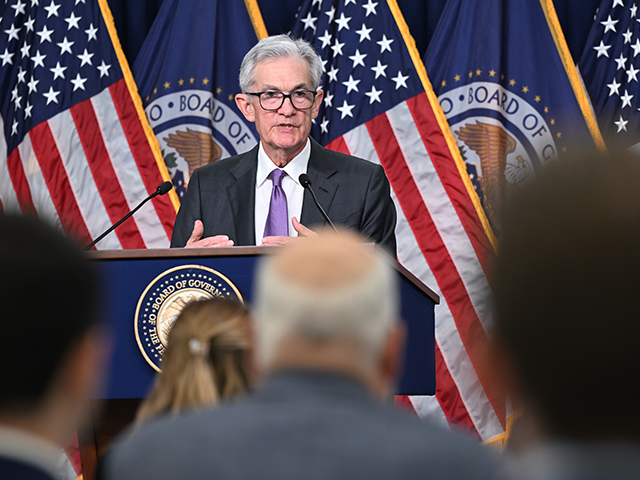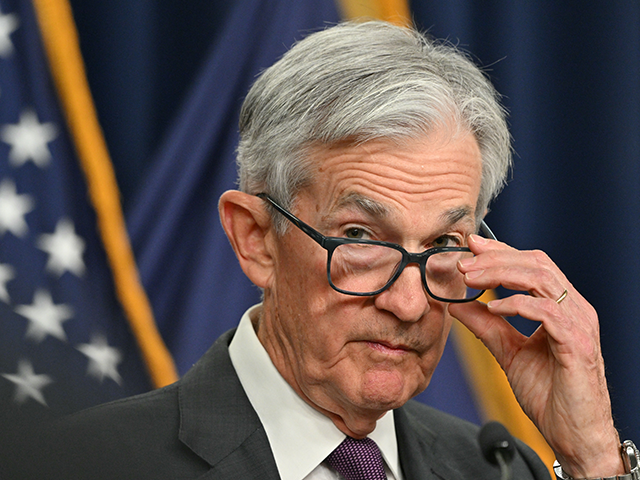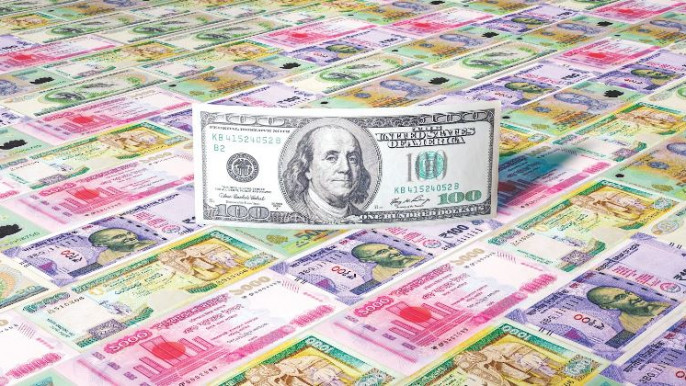from Economics Help
Fed Leaves Interest Rates Unchanged, Sees Economy as ‘Solid’
by John Carney
Breitbart.com
 The Federal Reserve looked past the recently reported economic contraction in the first three months of the year, describing economic growth as solid when officials agreed to hold interest rates steady on Wednesday.
The Federal Reserve looked past the recently reported economic contraction in the first three months of the year, describing economic growth as solid when officials agreed to hold interest rates steady on Wednesday.
“Although swings in net exports have affected the data, recent indicators suggest that economic activity has continued to expand at a sold pace,” officials said in a statement released at the end of the two-day meeting of the Federal Open Market Committee, the Fed’s monetary policy body. that
The economy contracted slightly in the first quarter of the year, the Commerce Department said last week, shrinking at an annual pace of 0.3 percent. But that was largely due to a surge in imports, which are subtractions in the calculation of GDP.
Nations Dumping Dollars, Loading Up On Gold in Global ‘Currency War’ | Ian Everard
Ian Everard warns of nations ditching the dollar for gold amid geopolitical tensions, signaling a potential “currency war” and a looming “catastrophic collapse” of fiat.
by PR
Jerusalem Post
In a recent interview on Commodity Culture, precious metals expert Ian Everard painted a stark picture of a global financial system on the brink, arguing that nations are increasingly ditching the U.S. dollar in favor of gold, signaling a potential “currency war.” Everard, owner of Ark Silver, Gold, Osmium, and a seasoned analyst in the precious metals sector, shared his insights on the geopolitical and economic factors driving this shift, warning of a potential “catastrophic collapse” of the fiat currency system.
Everard highlighted the ongoing trade war between the U.S. and China as a key factor contributing to the rising value of precious metals. “I don’t think Mr. Trump’s methodology of making deals works with nations,” Everard stated, suggesting that these tensions are creating an unstable environment where nations may seek safer havens for their wealth. This instability, he argued, is making gold an increasingly attractive alternative to the dollar.
Jim Grant Warns of Long-Term Inflation and a Secular Bear Market in Bonds
by Money Metals
GoldSeek
 On the Money Metals podcast, host Mike Maharrey interviewed James “Jim” Grant—founder of Grant’s Interest Rate Observer—for a sharp, historically grounded discussion on inflation, interest rates, and the fragile state of American fiscal credibility.
On the Money Metals podcast, host Mike Maharrey interviewed James “Jim” Grant—founder of Grant’s Interest Rate Observer—for a sharp, historically grounded discussion on inflation, interest rates, and the fragile state of American fiscal credibility.
Jim Grant is one of the most respected financial historians and market analysts of our time. With over four decades of experience, he has built a reputation for rigorous, contrarian insight through his publication, Grant’s Interest Rate Observer, which has been dissecting bond markets and central bank policy since 1983. He is also the author of several widely acclaimed books on finance and economic history, and a longtime critic of monetary excess and government debt.
With this deep foundation, Grant warned that the era of ultra-low interest rates is over, and what lies ahead could surprise even seasoned investors.
The First Crypto Currency: The Dollar
by Christopher Whalen
Daily Reckoning
 President Abraham Lincoln is considered to be the moral savior of the United States for ending slavery. To pay for the war, he made enormous changes in the basic relationship between the federal government and money. These changes greatly diminished individual property rights and increased the power of Washington over the private economy.
President Abraham Lincoln is considered to be the moral savior of the United States for ending slavery. To pay for the war, he made enormous changes in the basic relationship between the federal government and money. These changes greatly diminished individual property rights and increased the power of Washington over the private economy.
The paper money created by Abraham Lincoln to finance the Civil War was the first crypto currency. Lincoln relied on the issuance of nonconvertible paper currency to support the military effort, in today’s terms like forcing people to accept buttons or miscellaneous crypto tokens in payment. Lincoln used interest bearing paper “money” or “greenbacks” to finance the Civil War and, more significant, passed laws mandating the acceptance of paper currency as “legal tender” for all debts.
Breitbart Business Digest: The Economy Refuses to Play Nice with the Fed
by John Carney
Breitbart.com
 The Economy Throws the Fed a Curveball
The Economy Throws the Fed a Curveball
When the Federal Reserve officials last met in mid-March to decide on interest rates, they signaled hopes that the path of the economy would become clearer over time—giving them a solid perch from which to shape monetary policy. The economy had other plans.
In the seven weeks since that meeting, every key indicator has thrown a curveball. Growth is down, inflation is down, jobs are up, imports are up, and markets are wobbling. Stocks were down a lot in April until they weren’t anymore and ended the month flat. The Fed isn’t any closer to clarity, and the best bet for Wednesday’s meeting is more of the same: strategic hesitation.
Start with growth. First-quarter GDP fell at a 0.3 percent annualized rate, the first contraction since 2022.
Canadians Are Bracing for More Food Inflation Amid U.S. Trade War: New Report
Despite continued affordability concerns, trust in all food institutions increased, the second issue of the Canadian Food Sentiment Index shows
by Laura Brehaut
National Post
 Food prices remain top of mind for many, according to the second issue of the bi-annual Canadian Food Sentiment Index by Dalhousie University’s Agri-Food Analytics Lab (AAL).
Food prices remain top of mind for many, according to the second issue of the bi-annual Canadian Food Sentiment Index by Dalhousie University’s Agri-Food Analytics Lab (AAL).
Nearly 85 per cent of respondents reported that food prices have increased over the last 12 months. There was also a “dramatic” shift of perception in where food inflation might be headed over the next year. In the face of trade-war uncertainty, more than one in four Canadians are bracing for double-digit inflation.
Respondents expecting “more than 10 per cent” inflation jumped from 18.6 per cent in fall 2024 to 28.5 per cent in spring 2025.
“It’s not surprising that food is still a very big concern, and I think that’s important in itself because we have been focused on affordability of food for quite some time,” says Stacey Taylor, an assistant professor of business analytics at Cape Breton University and one of the report’s authors.
Warren Buffett’s Crystal Ball: Is the U.S. Dollar Headed for Collapse Amid Global Currency Shift?
from MSN

Speaking at Berkshire Hathaway’s 60th annual shareholder meeting, Buffett criticised US fiscal behaviour, calling it “alarming”. He questioned the long-term health of the dollar, pointing to reckless government spending and rising deficits. “A currency’s value can be a scary thing,” he said, especially when governments act without restraint.
The U.S. Keeps Printing Money. Why Can’t We?
Economists warn against the urge to print money during an economic crisis, because it can lead to hyperinflation. And yet, the US provided Covid-19 stimulus to its citizens by essentially printing money. Why are the rules different for different countries?
by Sheikh Rafi Ahmed
The Business Standard
 Currency is after all a piece of paper, which is why, during times of crisis, ordinary citizens have wondered why the government cannot simply print its way out of money troubles.
Currency is after all a piece of paper, which is why, during times of crisis, ordinary citizens have wondered why the government cannot simply print its way out of money troubles.
Economists, however, have time and again cautioned against the impulse to create more money. If the government creates too much money, people would end up with more money in their hands. Consumers would demand more and supply in the short run would fail to meet the sudden rise in demand. High demand pushes prices up, which in the worst-case scenario can lead to hyperinflation.
For instance, in 2008, inflation rose to 231,000,000% in a single year in Zimbabwe, because of the government’s mistreatment of the currency as its piggy bank. A sweet which previously cost only one Zimbabwean dollar cost 231 million Zimbabwean dollars a year later.
Fed’s Balancing Act: Inflation, Growth, & Trump’s Tariffs
from Yahoo! Finance
![]() The Federal Reserve faces a high-stakes decision this week as it weighs sticky inflation against a slowing economy.
The Federal Reserve faces a high-stakes decision this week as it weighs sticky inflation against a slowing economy.
Yahoo Finance Senior Reporter Jennifer Schonberger joins Catalysts to break down what to expect from Wednesday’s policy meeting and Fed Chairman Jerome Powell’s press conference.
To watch more expert insights and analysis on the latest market action, check out more Catalysts here.
What to Expect From April’s CPI Inflation Report
by Simon Moore
Forbes
![]() April’s Consumer Price Index inflation report, scheduled for release on May 13, should be another relatively muted inflation reading according to nowcasts. That may support an interest rate cut in June. However, tariffs remain a wildcard.
April’s Consumer Price Index inflation report, scheduled for release on May 13, should be another relatively muted inflation reading according to nowcasts. That may support an interest rate cut in June. However, tariffs remain a wildcard.
Nowcast Forecasts For Inflation
Nowcasts project broadly 0.2% monthly inflation for the month of April, according to Cleveland Federal Reserve models. That forecast is broadly consistent for both headline and core inflation, and for the CPI and Personal Consumption Expenditure inflation readings. It translates to annualized inflation of approximately 2.5% or a little above the Federal Open Market Committee’s 2% annual inflation target.

